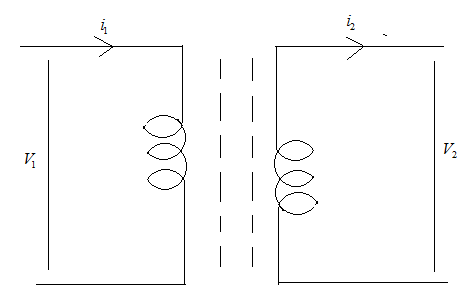
Draw a labelled diagram of a device you would use to transform 200 V ac to 15 V ac. Name the device and explain how it works. Give its two uses.
Answer
569.1k+ views
Hint: In this question, we need to draw a labelled diagram of a device that would be used to transform 200 V ac to 15 V ac. For this, we will use the basic electrical concept to get the result.
Complete step by step answer:
Input voltage \[{V_{in}} = 200V\]
Output voltage \[{V_{out}} = 15V\]
Here since input voltage is greater than the output voltage, we can say the voltage is being stepped down, and this occurs in a step-down transformer.
We know that the level of voltage in the transformer is changed by increasing or decreasing the number turns of windings and in a step-down transformer turns in the primary winding is more than the turns in the secondary winding.

A transformer works on the principle of electromagnetic induction, which states the rate of change of flux linkage with respect to time is directly proportional to the induced emf in the coil.
When an alternating voltage is supplied to the primary coil it produces a continuous changing flux and this flux links with the secondary winding, and according to Faraday's law of electromagnetic induction when a coil is brought in a continuous changing flux-region an emf is induced, and this emf produces a voltage in the secondary coil.
Some of the major applications (uses) of the step-down transformers are impedance matching, isolating two circuits electrically, rectifiers, relays, etc.
Note:Since the voltage is being transformed from 200 V ac to 15 V ac it is a step-down transformer. A transformer is a static device which transforms power from one level to another level without frequency being changed.
Complete step by step answer:
Input voltage \[{V_{in}} = 200V\]
Output voltage \[{V_{out}} = 15V\]
Here since input voltage is greater than the output voltage, we can say the voltage is being stepped down, and this occurs in a step-down transformer.
We know that the level of voltage in the transformer is changed by increasing or decreasing the number turns of windings and in a step-down transformer turns in the primary winding is more than the turns in the secondary winding.

A transformer works on the principle of electromagnetic induction, which states the rate of change of flux linkage with respect to time is directly proportional to the induced emf in the coil.
When an alternating voltage is supplied to the primary coil it produces a continuous changing flux and this flux links with the secondary winding, and according to Faraday's law of electromagnetic induction when a coil is brought in a continuous changing flux-region an emf is induced, and this emf produces a voltage in the secondary coil.
Some of the major applications (uses) of the step-down transformers are impedance matching, isolating two circuits electrically, rectifiers, relays, etc.
Note:Since the voltage is being transformed from 200 V ac to 15 V ac it is a step-down transformer. A transformer is a static device which transforms power from one level to another level without frequency being changed.
Recently Updated Pages
A man running at a speed 5 ms is viewed in the side class 12 physics CBSE

The number of solutions in x in 02pi for which sqrt class 12 maths CBSE

State and explain Hardy Weinbergs Principle class 12 biology CBSE

Write any two methods of preparation of phenol Give class 12 chemistry CBSE

Which of the following statements is wrong a Amnion class 12 biology CBSE

Differentiate between action potential and resting class 12 biology CBSE

Trending doubts
What are the major means of transport Explain each class 12 social science CBSE

Which are the Top 10 Largest Countries of the World?

Draw a labelled sketch of the human eye class 12 physics CBSE

How much time does it take to bleed after eating p class 12 biology CBSE

Explain sex determination in humans with line diag class 12 biology CBSE

Explain sex determination in humans with the help of class 12 biology CBSE




